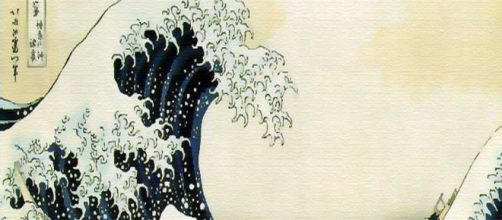You must have seen this picture a jillion times on T-shirts and mugs. Yet, it made headlines last week.
Called The Great Wave, a print made from a woodcut by Japanese artist Hokusai Katsushika in 1831, sold at Christie's in New York for a record $1.6 million – 10 times more than the estimate of $150,000 reported by Art News. Information from Artfix Daily further noted global participation at the auction representing 35 countries.
A raging sea
This image, which describes a towering ocean swell cresting and about to break, is also known as Under the Well of The Great Wave, and that's how I knew it in real-time while swimming in the Atlantic off a Long Island coast in 1981.
That's when a part of the incoming tide climbed abruptly to the sky, mushroomed over me, threatening like an angry beast.
Admittedly the sea was rough to start with that day. But seeing a monster wave loom so suddenly was a jolt. I was terrified. The only way out of its path was to get under it. But as I soon found out, while the waters behind it were out of the way, their turbulence made it nearly impossible to swim or even tread, and I wondered how long I'd have the strength to keep my head above water.
Facing one's mortality
A lifeguard was on duty on the beach, but I was too far out for him to see me. In the choppy water, I could barely see him, catching only glimpses. Obviously, I survived to tell this tale, but staying afloat was the hardest thing I've ever done.
Knowing my two children were waiting on the beach pushed me forward.
Looking at Hokusai's image now is like looking into memory as fresh as if it happened this morning. The Great Wave haunts me still. You might call it my Stendhal Syndrome moment since my pulse can quicken just thinking about it.
The Stendhal Syndrome
You may remember the syndrome described by the 19th-century French writer Henri-Marie Beyle (Stendhal was his pen name) when he saw Giotto's ceiling painting in Florence's Santa Croce Cathedral: "I had palpitations of the heart." I don't claim ecstasy as he did.
I think now that the wave I ducked could not have been as huge as The Great Wave, but Hokusai's vision continues to move me viscerally.
In a panic
Reportedly, the Stendhal Syndrome is an actual thing affecting hundreds visiting the Uffizi Gallery in Florence in 1979. That's when Italian psychiatrist Dr. Graciella Magherini, chief of psychiatry at Florence's Santa Maria Nuova Hospital, observed Uffizi Gallery visitors complaining of lingering panic attacks.
Dr. Magherini decided to give it a name in honor of the first person who reported the symptom. She wrote a book about this in 1989 - La Sindrome di Stendhal.
But you don't need to travel to the Uffizi to feel the power of an artwork. Even if a near-drowning isn't your experience, the Great Wave is a mighty image.


